Honey, We Meet Again
When a bicycle leaves you at a loss for words, is that a good thing? With hundreds of miles now on this Honey Cyclocross demo bike, I am leaning toward yes. Because I'm not exactly itching to give it back.
Last summer I was briefly without a suitable bike for dirt and gravel. When a local unpaved ride came around, a buddy lent me her Honey Cyclocross racing bike. I wrote about that bike here, then rode the Kearsarge Klassic on it successfully. And that should have been that. But months later, even as I happily rode my own bike, memories of that CX Honey kept intruding. In my first impressions write-up I described how "different" its handling felt from anything I'd tried before. As a wannabe bicycle designer, this gnawed at me. What was it about that bike?
Enter geographical luck of the draw. Honey Bikes are local to me, the project of Rob Vandermark whom I know through the Ride Studio Cafe bicycle shop and Seven Cycles. Last Fall, we had occasion to talk about the cyclocross bike I'd tried, and I struggled to articulate why I found its handling so "different."
At this time, a batch of Honey demo bikes was being prepared for the Ride Studio Cafe, and one of them was set up for me. The idea was a long-term test ride and review: I would ride the bike until it became familiar, allowing me to articulate what I found so striking about its handling. In particular, we discussed how appropriate a bike like it might be for long unpaved rides, and how it compared to the 650B low trail model I was comfortable with.
The bike arrived just as a series of snow storms hit the Northeast, which made for some appropriate pictures of the "winter lilac" colour.
I should note here that the bicycle reviewed here is completely stock in everything from size and geometry to component group and finish. Honey bikes are not custom, but made-to-order stock bikes, available in a variety of sizes and option packages. This production method allows them to keep prices in the $2,400-4,000 range for complete bikes, and to offer quick turn-around. The bicycles are steel, with carbon fiber forks (though steel forks are also available). Models include road, utility, mixed terrain, mountain, cyclocross and more. All frames are handmade in the USA, the current series produced by Seven Cycles in Watertown, MA.
Honey bikes are offered in two types of finishes. The standard finishes are tone-on-tone, and so subtle that the logos and other markings are virtually invisible unless you stand inches from the bike or intentionally bump up the contrast in pictures to draw them out. For those who prefer a finish with visible logos, Honey also makes "team" finishes, where the panels and lettering contrast the main colour.
Like the bike I had borrowed last summer, this is a stock 52.5cm Honey Cyclocross race frame (they also have a utility cross model, but this is not it). The sizing figures on Honey bikes refer to the virtual top tube length. Because this bike was set up for me from the get-go, it fit me much better than the one I rode previously. The handlebar height and width, the stem length, and the saddle position were configured with my fit in mind. The brakes were routed right=front, the way I set up my own. When I got on the bike, everything immediately felt natural, and there is a lot to be said for this. With roadbike test rides, fit really matters.
The Honey was set up with a SRAM Rival group and TRP mini-v brakes. The brakes work excellently (more on that here), which was a great relief from previous experiences with cantis. And while I have a Campagnolo setup on my own bikes, I am also comfortable with SRAM levers and have no problem switching back and forth between the two systems.
As I see it, going with SRAM on a bicycle like this has several benefits. The main one, is that SRAM now makes it possible to use low gears with a road drivetrain and modern integrated shifters. Their new wifli system, despite the silly name, is extremely useful in that it allows for a 12-32t cassette. Paired with a 50/34t crankset, that almost gives you a 1:1 low gear, without having to do anything unconventional to the drivetrain. Unofficially, I am told that the wifli derailleur will also handle a 34t cog from a mountain or touring cassette, but I wanted to ride the bike with everything stock before trying out-of-spec configurations. As is, the SRAM Rival drivetrain has been functioning flawlessly ...which brings me to the other benefit - the value. While I love the feel of Campagnolo Chorus, I've been disappointed with their lower-end groups in the past couple of years. At the lower to mid range, I have to admit that SRAM groups feel nicer. In particular, I find Rival to be the sweet spot as far as cost to performance ratio.
The bike is fitted with Mavic Ksyrium Elite wheels and Continental Cyclocross Speed tires, 700Cx35mm. The tires were chosen for their versatility: The tread can handle most unpaved terrain, without slowing the bike down too much on pavement. I have found this useful. Off pavement, I feel comfortable with these tires on dirt, gravel, reasonably shallow sand and not-too-thick mud. On pavement, I do find them slower than slick road tires, but it's not too bad and I don't mind working a little harder on paved sections. These tires are also great in the rain and light snow. In bad weather, I find myself reaching for this bike.
Speaking of snow... Though I did not ride a lot over this past winter, the little riding I did was mostly on the Honey. Partly this was due to the tires: They handled unexpected patches of ice and snow on the road better than the tires on my own bikes. But partly it was also the handling. I will get more into this later, but when I got the demo Honey, fitted to my riding position, my first impression was that it felt like a toy - I was compelled to try stuff on it that I had not done on other bikes - like jumping over things and riding in snow. So I did, until eventually I crashed into a tree riding in the woods. My leg and hip were covered in bruises that took weeks to heal, but luckily the bike was fine!
Spring took a long time arriving this year. But finally by mid-March I started putting in some proper miles. As a way of ensuring I get used to the Honey's handling, for some time I rode it exclusively: Group rides, solo rides, paved rides, dirt rides, short rides, long rides - for 3 weeks straight it was all Honey, all the time. After that, I began riding my own bikes again (skinny tire road and fat tire dirt), alternating between the Honey and them.
For some time, I marveled at the handling every time I got on this bicycle. I am going to use experiential terms here. One term that comes to mind is "hyper hip-steerable." Maybe even "rear wheel drive." That is, the bike struck me as overly sensitive to movement at the hips, to the point that it almost felt like the front end was controlled from the back. For instance, let's say I was behind a rider and wanted to pass them. On this bike, I discovered a maneuver, where I could flick my hips ever so slightly while accelerating and "slingshot" past the rider in front of me in a tight, perfectly controlled arc. Maybe that sounds crazy, or maybe this is something everyone but me has been doing all along, I can never tell. In any case, it's easy and intuitive to do on this bike.
But unless I intentionally fling it sideways, the bike has a "tracks straight" feel to it at all speeds. Even when walking it I can feel this: Using the gentlest touch, I can easily steer it by the back of the saddle and the front won't turn or flop to the side. Riding it at excruciatingly slow speeds is easy as well; it really "wants to stay upright" and go straight.
Hopping over bumps, rocks and roots is unusually easy. The first time it happened, I simply saw a huge root in front of me, and before I knew it my front wheel was sailing over it and landing on the other side. I was not conscious of having pulled up on the handlebars. I can now hop over objects on other bikes too, but it takes more effort.
On descents, initially I found that I could not easily turn and maneuver this bike using the same approach as on others I've ridden. But I quickly learned that changing my balance over the saddle made it controllable in these situations. I still do not understand this part entirely, but my subjective feel is that I almost hang off the bike to the side in order to steer it on turns. Possibly, this is my way of compensating for not being able to lean the bike itself sufficiently.
All the characteristics described become less noticeable the more I ride the bike. But if I go even as much as a week without riding it, I immediately notice them again when switching from my own bicycles. It's not a matter of better or worse, but just a "Hey, this is different!" kind of feeling every time.
The aesthetics of the Honey Cyclocross bike are modern and sporty: thick tubes, unabashedly sloping top tube, straight fork. This look is growing on me - or maybe a more accurate way to put it would be "I appreciate it for what it is." I do love the winter lilac finish. The welds are very smooth, more or less invisible under the paint. And the overall look has a unity and harmony to it that makes sense to me visually.
The tubing is oversized and thin-walled. Pinging it with my fingernail, there is a distinct hollow ring. Riding the bike, it feels extremely stiff - though not in a disagreeable way. It feels light in motion, fast to accelerate, ever-ready and ever-awake. Despite the stiffness, the ride is not harsh. The jury is still out on the relationship between flex and responsiveness to pedaling effort, and I won't attempt to make any connection here. I will only say that I enjoy how stiff this bike feels.
I intentionally did not look at the geometry in advance, so as not to bias my impressions. When I did have a look later, I did not see anything too unusual. Longer chainstays and less bottom bracket drop than typical with road geometry; slightly higher trail. None of it seemed sufficiently dramatic to explain my strong reaction to the bike. Maybe it's one of those "the whole is greater than the sum of its parts" things. There is, after all, a lot I don't understand about bicycle design.
The one word I would use to describe the Honey Cyclocross bike is "fun." As in exciting, playful, toy-like. This bike really moves, and under a more skillful rider than me I am sure it would move even better. While I am obviously not evaluating it in that context, I can see how a bike like this would make a good choice for racing cyclocross.
As far as unpaved brevets and such, I think the CX Honey could work nicely for those who want a lightweight, modern, racy bike with wide 700C tires. Although designed for short races, to me it feels great over 100K distances. The main thing, is that after hours in the saddle I find it delightfully non-fatiguing.
Not being a utility bike; this particular Honey model is not built for racks or carrying heavy loads. Riding it with a full, wide Carradice-style saddlebag in the rear, I can feel the weight (or drag - not sure which). With a smaller bag that tucks under the saddle (like the Dill Pickle shown here) this is considerably less pronounced. I have not tried a bag on the front - though I've now been lent an Ortlieb system to experiment with, and will report back.
Riding this bike on dirt and gravel, I am as fast as I'm capable of being, and reasonably confident riding over most types of terrain I encounter. On pavement, I am slower on the Honey than on my skinny-tire roadbike. And compared to my low trail 650Bx42mm all-steel bike, the Honey is on average about the same both on pavement and dirt. One aspect where they differ, is if I try to seriously push the speed beyond my comfort zone - for instance, in order to keep up with faster riders. When doing this, I can push both bikes pretty hard, but on the Honey I feel less tired afterward. The 5lb difference in the weight of the bikes could account for this, as could the difference in frame and fork materials. On the other hand, when all is said and done I prefer my own bike's front-end handling. It is simply more intuitive to me, and on challenging terrain with twists and turns I am generally more relaxed and precise on it for that reason. Nonetheless, I appreciate the Honey's handling as well. I especially enjoy switching between the bikes and experiencing the difference, adapting to one then another.
It fascinates me to no end how two bikes can excel at the same task, yet ride and feel so differently. I will elaborate on this shortly, but recently I began working with Rob Vandermark on a special project. My experience with the CX Honey - in conjunction with my own bike - has been particularly educational in that context.
With unpaved riding increasingly popular, it's exciting to have choices for go-fast bikes with fat tires. The Honey Cyclocross bike is certainly worth considering - fast, fun, made in Massachusetts, and reasonably priced with lots of sizing options. It's been a pleasure getting to know this bicycle, improving my handling skills and expanding my horizons in the process.

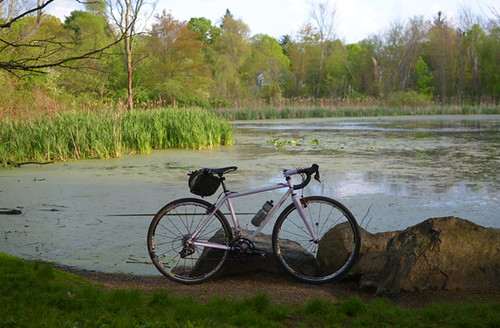
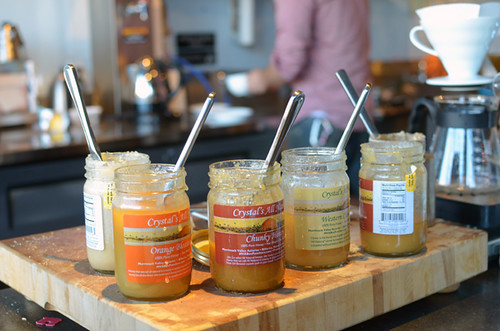
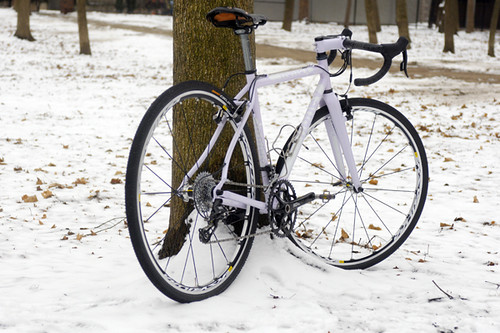
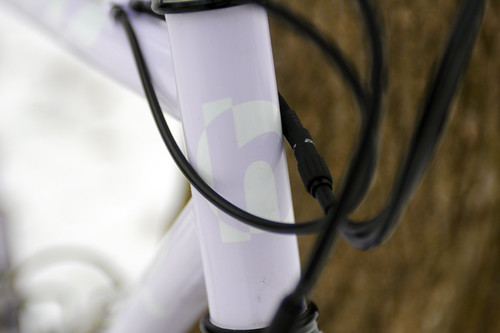
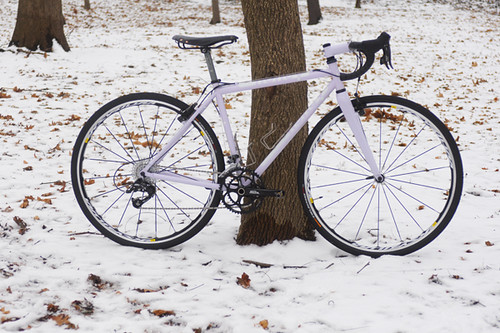


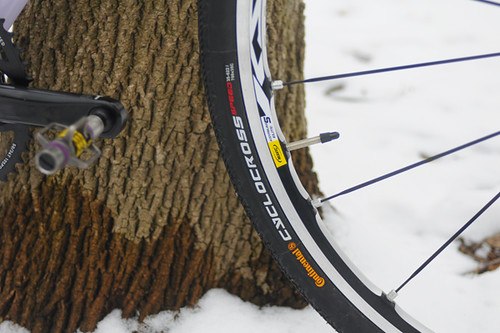
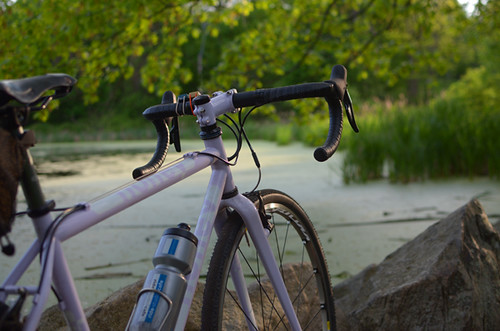
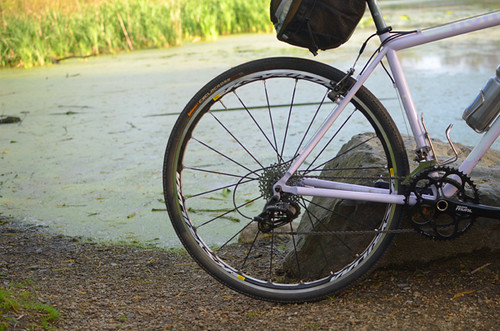
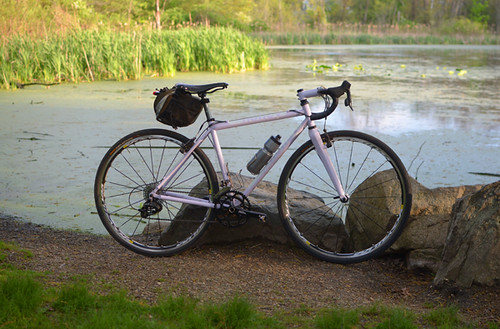
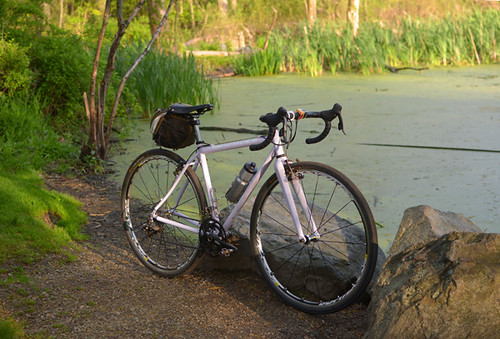

The brakes appear to lack sufficient mud clearance. It is one reason I changed back to cantis on my own cross bike.
ReplyDeleteThe braking power on these compared to any cantis I've tried is night and day, so that's the main draw for me. I doubt I would ever ride through mud thick enough for the clearance to be a problem.
DeleteMud that will clear a v-brake is only thick water. For competition use v-brakes require a backup bike with cantis or mad wrenching to switch brakes when the course is muddy. Top competition is not still on cantis because they are foolish enough to want to race with weak brakes. For persons of normal hand strength the difference in braking power, if any, is not so crucial.
DeleteV-brakes also require perfectly true wheels. Lightweight riders always using high-priced nearly new overbuilt heavy wheels may not have a lot of experience with wobbly wheels. Wobbles that a canti wouldn't even notice stop v-brakes cold.
There are plenty of people with normal hand strength who find cantis weak; you only need to look at the comments in the TRP review I linked to, to see that. This is one of those discussions where opinions tend to be inflexible, so to each their own and please let's not turn this into another canti debate. Obviously the Honey XC frame will take either v-brakes or cantis and the bikes are available with either. There is also a disc version. Whatever your preference, it's cool with me.
DeleteI am very interested in these tires. How would you describe them compared to Grand Bois Hetres?
ReplyDeleteTo me, these tires feel like an ideal choice for riding a 700C bike on unpaved roads; they are what I would put on my own bike. Perfect width and tread, quick rolling with a light feel to them, and they are not too painful on pavement either (the Racing Ralphs I rode last summer were just brutal on pavement). Unless you are frequently riding through thick mud or some other unusually tricky terrain, the Continental CX Speed should be enough tire for the job.
DeleteI am not sure how to compare them to Grand Bois Hetres, since they are intended for different wheel sizes. But the obvious difference is that the Hetres are wider, with slicker tread. On normal dirt/gravel roads I feel equally comfortable on both tires. The CX tires are perhaps grippier when encountering something slippery or slick.
All bikes steer from the saddle. Everyone has been doing this all along. Steering sensitivity varies among different bikes. I've never heard a satisfying explanation for why this is so.
ReplyDeleteYup. With this bike, the steering from the saddle feel is more obvious or exaggerated, is what I tried to communicate.
DeleteOnly mid trail and high trail bikes steer with the hips. Low trail bikes steer with the bars. Most bikes are mid to high trail, which I prefer.
DeleteHey Mike, If I want to try low trail, do you think there is any useful experience to be gained if I made a fork with two positions on the forkends? I realize that there's a lot more to optimizing things than just moving the wheel forward 15mm, but fabbing some dual position tabs would be a simple way to make quick comparisons on the same bike on the same terrain... Would I get a clear picture of the differences or just waste some time?
DeleteSpindizzy
Since Mike generally doesn't respond to these I'll just say I think it's an excellent idea that is try. Something with braze-ons for a proper platform rack and horizontal sliders to not screw up the frame geo.
DeleteI'm serious - someone's got to do a real test of this stuff.
Somewhere on the interwebs I've seen such a fork, with two axle dropouts corresponding to two different amounts of rake.
DeleteI think I can get my hands on just the fork to do it to, further bulletins as events warrant...
DeleteSpindizzy
Yay, Spindizzy's gonna fire up the torch!
DeleteI too would like to hear of the difference; it sounds a little like a variation on the fork dropouts that Seven uses.
Say, didn't GT do a fork with extended dropouts for one of their bikes in the late 90s?
There were some BMX forks with dual slots back when the air was clean and we were all pure of heart so it's not a new invention. It seems like it would be an effective way to explore the trail effect. Can anyone think of a reason it wouldn't?
DeleteSpindizzy
Here you go - GT Tachyon.
Deletehttp://sfcyclotouring.blogspot.co.uk/2008/05/gt-tachyon-great-idea-that-happened-too.html
Curiously, I found that link only the other day after seeing reference to it under one of Velouria's posts about the Royal H Randonneur - must be psychic. The fork had adjustable offset with four different front wheel locations. You'll find other photos, etc, if you search around further (but I suspect Spindizzy's already got it sussed!).
Can't help but wonder if the great Jeff Jones was involved with the Tachyon project - he was GT's R&D tech for a while before he struck out on his own. The frame bears his hallmarks, and he's always been a maverick.
Seven's fork dropouts (fitted to Velouria's Seven Axiom S) are clever and should be de rigeur - somewhere on Dave Kirk's website you'll find a withering put-down of 'Brand X' manufacturers who fit 'one-size-fits-all' (not) carbon forks, all with the same offset, irrespective of various different head angles, which leaves the trail figures all over the place. Seven offers the solution.
Spin you're changing the front center; I don't know what the bible is on this low trail stuff. As long as the two points are horizontal you aren't changing the frame geo.
DeleteYou see people laying down all sorts of "rules" about building LT bikes, changes to BB height, stay length and so forth that they say are "necessary" to achieve a stable LT bike. It seems to me that whatever benefit there is to those mods is incidental and a well designed conventional bike will still exhibit the basic characteristics of LT behavior just by moving the axle around(in the same horizontal plane of course). I might be wrong but I'm fixin' to find out...
DeleteI'm mostly interested in low speed climbing behavior(the degree to which reducing "wheel flop" improves climbing efficiency) and high speed tracking. This is all Jan Heine's fault for making me think about all this stuff. I was perfectly happy and oblivious before. Thanks Jan, like I needed another project...
Spindizzy
Only skimmed this thread of comments, but I think the design you're talking about might already exist, via Jim Papadopoulos. I'll investigate.
DeleteFred Delong had a custom Paramount with that fork. Featured in an old American Cycling (predecessor to Bicycling) article and also shown in his book. None of this is online AFAIK. I got the book if you need a scan, the mag article only in the memory bank. Pretty basic. Cut a dropout with a horizontal slot, braze it in.
DeleteEffective trail is based on where the tire contact patch is. For most purposes you drop a vertical line through the axle to find where the patch is and do the math. Offroad, and for a lot of other purposes, the contact patch is where the tire hits the log. It's somewhere in that mud. And of course going uphill or downhill throws the calculation out of whack. Something as simple as leaning into a turn makes the math of trail darn complicated. And moving weight on or off, towards or away from the front wheel changes the handling of any bike drastically even as mathematical trail remains constant.
DeleteSo antbikemike is correct in a textbook sort of way but all bikes steer with the hips. Every rider alive steers with the hip even if they fight it or deny it. There's nothing unusual or magic about this Honey. Steel cyclo-x frame. This post is about V getting some mojo in the hip.
For what it's worth, it's really, really difficult to get a motorcycle to do anything without your hands on the bars. You can go around a turn on a bicycle but on a motorcycle you'd have a hard time changing lanes. This is not usually important since you usually need your right hand to stay on the bars most of the time to gas or brake. ("A miracle that all this docile strength waits behind one tiny lever for the pleasure of my hand." -TE Lawrence)
DeleteSport bikes have about 3.5" of trail and big touring cruisers can get up to 7" ish based on some googling I just did.
Mem day comment -- throw in a quick counter steer and the bike falls into the turn, no hip necessary.
DeleteNo hip in extremely tight turns or low low speeds.
Interesting. The geometry of this Honey is nearly identical to the one on my own bike, with the only obvious difference of more sloping top tube on Honey.
ReplyDeleteHow about toe overlap? You usually mention this.
Wow I forgot to mention toe overlap!
DeleteNo TCO with 35mm tires (assuming my size 38Eur shoes, my particular cleat position, etc.). It is close though, so with bigger shoes or with a fender or a wider tire you'd have it.
I know looks aren't everything, but this is a very pretty bike! I like your setup too.
ReplyDeleteGotta say it looks smaller than the dark cherry bike from last year, are you sure they are the same size?
ReplyDeleteThey are the same size; I've even placed them next to each other and the frames are identical. My bars sit almost 2" lower than my friend's and my saddle is a bit lower and further forward. Changes like this can make the bike itself look smaller.
DeleteHave you ridden a Seven Mudhoney?
ReplyDeleteI assume there's a shared lineage from the muds to the honeys and your description sums up my ride experience well.
Funny, I was just discussing this very bike and your forthcoming review yesterday with a mechanic/pro fitter friend. He was looking forward to your review, as well.
ReplyDelete(He was setting up a dark green Rock Lobster CX bike to be fitted for a woman client while we talked. it had a SRAM Rival group, too. Must be something in the air.)
Nice to hear your fleshed-out and considered thoughts on the bike.
I do have to say that you are not making this bike any *less* attractive to me! I will have to find a local dealer (if one exists) and test a few of the frame types out.
Good God you have outdone yourself - too much caffeine?
ReplyDeleteThe geo chart you linked to has no hta or fork spec. Hello? Think that has anything to do with where...
Your CENTER OF GRAVITY IS?!
Before I forget I think it's ridic you still run a 50 chainring with a 12 cog. You said you hardly use the 50. You need something like a 44/34 with a 15-48. Or a triple without the outer ring.
Do I gotta mansplain everything here? Your weight is more back, on your hips. You are basically skiing. The front end is designed to be pick up-able. Hello - you're comparing a heavy steel fork to a carbon one. Is something heavier harder to pick up?
You want a cross bike to stay up in slop - more rubber on the earth. Watch the big boys use body english and stop getting excited.
Measure, don't take someone else's word for it or you'll never learn, your handlebar HEIGHT, not drop, compared to your road bikes. Carry a tape measure everywhere and use it. I do.
Not gonna touch that slingshot thing.
Going back to the fork thing - it's not all hta, rake, trail.
That big-ass bag in the back you're going to feel more because, hello, the bike is light and the weight of it is biased rearward. Sigh.
Where the bike puts your weight naturally. Study that.
This is excruciating:
"When doing this, I can push both bikes pretty hard, but on the Honey I feel less tired afterward. The 5lb difference in the weight of the bikes could account for this, as could the difference in frame and fork materials"
How about speedy cross tires vs. huge fat Hetres? How about wheels? It's not Honey vs. Rawland, those are just frames. It's about the components too, which I've been harping on for years to no avail.
Everything on the Honey is about Race.
Everything on the Rawland is about Ride.
There is an absolutely huge difference.
Also you are using the right tool for the job - learn to do stuff on the right bike or beat your head against the wall riding road bikes on increasingly gnarly terrain.
She did make the connection to the "Rear Wheel Drive" effect. She gets credit for sensing some incipient oversteer dontcha' think? 10 points for Griffendor!!
DeleteSpindizzy
Damn that is some fine mansplaining. But I gotta motor if I wanna be ready for that party tonight. BRB.
DeleteToo. Much. Sensation. Must party. Riot 2 stroke wheelie cancels bike over/under think.
DeleteBRB = braappp.
GR Jim, you've touched on a subject that intrigues me, as it may relate to the bike I've been riding.
DeleteA friend gave me an old Univega NuovoTech 450 that he'd had just lying around. When I got it, I found myself having difficulty getting along with the drop bars, so I swapped them out for something a bit flatter.
Suddenly a bike that seemed to be about the right size with its stock setup started fighting me in terms of fit. I've got the bars on a 100mm stem, and the Selle An-Atomica saddle as far back on its rails as it'll go, on a seatpost that I'm told has about as much setback as it's reasonable to get. You can see it here: https://fbcdn-sphotos-b-a.akamaihd.net/hphotos-ak-ash3/944334_891335928699_1104287905_n.jpg
I love the way the bike handles...I find it very easy to "hover" with, and it takes turns very quickly, and all that...but I feel that the frame size is a touch too small with this bar setup. At the same time, I wonder how much the saddle's location relative to the BB and rear axle are responsible for this. I've been reading about cross bikes for a couple days now, and have been curious about how the handling is likely to compare.
Specific bikes of interest: Raleigh Roper and Bianchi Volpe.
Ag ride those.
DeleteI've test-ridden a bunch of bikes over the last couple days...Cross Checks, Volpes, Specialized Tricross Sports, the Gunnar Crosshairs at Harris, a Salsa Vaya, and I finally found a Roper in my size to try today.
DeleteI started off looking at bikes that were a little too big, but once I figured out the correct size, I discovered that I actually don't hate drop bars like I thought I did. It's amazing how much the reach makes a difference for me, in terms of confident braking.
With all of that, I think I've come to a decision: Volpe in the 51cm size. Now I just have to find the cash for it!
I love the transition from winter to spring here :) The only thing this review is missing, is a picture of the bike next to some lilacs!
ReplyDelete-P
Ahem. I do have better pictures somewhere.
DeleteI helped a friend assemble a new Sram Rival-equipped bike recently. I had never worked on that shifter/derailleur combo before, so it was a bit of an adventure. The 10-speed setup intimidated me at first. And trying to figure out cable routing, derailleur adjustment, etc., took a while. Fortunately, YouTube came to the rescue, and everything went together pretty well. I took a brief test ride and must say I was pretty impressed with the Doubletap shifters. I also liked the crankset/bottom bracket: very stiff and light. My friend had sourced most of the components on ebay, some used and some new. He said he saved a lot of money by shopping around. So, perhaps you could review the Sram system at some time?
ReplyDeleteHere's a related question: Is the stuff in jars what Honey uses to pack its bearings? Perhaps that explains the sweet ride characteristcs.
It is a cyclocross bike, that's why it is so fun to ride. What is the tubing, I will go look that up.... I have seen some modern steel bikes with modern columbus tubing and are oversized. Columbus have designed the tubing like this to reduce flex, or so I was told. I do not like the look and am a tiny rider so fear it could be overbuilt, but if the ride was worth it, never mind the weird tubes. Did you ever try this bike with the steel fork? The seven can also be built with a steel fork, I would be interested to know what the difference is, or advantage to carbon.
ReplyDelete$2000-4000 is a large amount of money for what could be an occasional bike. I would love a cyclocross bike for my secret cx racing fantasies, but as it is I need to have a bike that can do it all. I have been riding for transportation, fun, fitness for my whole life, almost 2 decades seriously since I was a teenager. I have never been able to afford anything like that. I know from experience, better quality is always the way to go, but as it is I'm still scrambling with vintage ill fitting bikes and mish mash parts. It's great to see your transformation, and how riding and experiences can change with such a wonderful variety of bicycles. I know it is a great benefit that you are able to test such great bikes with your perspective(woman, not always confident, low strength hands), but it may be prudent to feather things out with some reviews of lower cost bikes even as a comparison.
This is a funny review to read, but at the same time I know exactly what you mean. Drumroll... Welcome to the world of cyclocross bikes!
ReplyDeleteAlso: tt slope, frame triangle size.
ReplyDeleteHaha...the good news in this post has nothing to do with the Honey, which is clearly a good bike, but that you now have an open mind about the sloping top tube!!! Yeah!!!!
ReplyDeletePshaw. My Seven has a 2deg slope!
DeleteBrilliant! Like all you do...small steps:)
DeleteVelouria, quite the confirmation of my own experience with a steel Euro CX bike (1990s Bianchi Reparto Corse with very light oversize tubing, very stiff, faster handling than your MudHoney). It is my "go to" all-rounder, yet is quite fast on the flats with 35 mm slicks. For crankset, try a 46x34 (typical 'cross setup is 46x36). It's the sweet spot between an over-geared road 50 and under-geared touring 44. Swap cassettes depending on event.
ReplyDeleteIgnoring the CX racer crowd, you can get a good canti with dual compound Kool Stop pads to work quite well (no one ever mentions the rim has something to do with braking force), albeit with a lot of experimental setup time. A good mini V-brake (for road levers) could be setup by a 10 year old to get great performance. I had rather spend time doing other things than perfecting canti brake setup (of course it actually took doing that to reach that realization).
Bill in Roswell
Lovely photos - the 'Winter Lilac' Honey looks awesome in the winter snowscape - but in the spring it looks out of its element, like a mountain hare caught where the snow has melted before its coat has changed colour. A honey Honey would suit the spring, summer and even the autumn (they actually offer such a colour - 'True Honey'), but I don't suppose you can change the colour of your bicycle to suit the seasons! When I first went to their website it showed a flat black Honey, which looked like nothing, except night, perhaps, without a moon.
ReplyDeleteColour is profound. For years I was perplexed as to why the iconic Gulf auto racing colours - powder blue and orange - worked so well, notwithstanding their legendary association with Ford GT40s and Porsche 917s. I was looking at the sky one evening, just after reading a post you wrote about colour - 'Variations on Red and Green' - when the penny finally dropped: 'Red sky at night, shepherd's delight' - orange light in a pale blue evening sky, and the prospect of a fine day tomorrow.
Incidentally, re. mountain hares, I used to see them when I drove via Glenshee from Ayrshire in the southwest of Scotland to Aberdeen in the northeast. It's just occurred to me that the distance from Ayrshire to Glenshee - from the Lowlands to the Highlands - is just about the distance you cycled on your 200K brevet. And that's like... Wow.
Just about the most extreme high trail bikes (apart from pacers) must be cycle speedway bikes
ReplyDeletehttp://www.archie-wilkinson.co.uk/Bikes.jpg
No fork rake at all and steered by pushing the whole thing down into the turn. Great for speedway, terrible for anything else.
I'm thinking the "mystical"ride quality you describe comes from the higher CoG that comes with the typical cx bike. A high BB, which translates to less bb drop, will give you a higher center of gravity, and with all other things being equal, you'll have a more flickable bicycle.
ReplyDeleteNow, this being Lovely Bicycle, you'll tell me that you already knew that (which I'll believe)and that it's actually some other, ethereal quality about the bike that you cannot define, but that is probably just magic (which I won't believe).
But, yeah, the "slight" difference in BB drop? It ain't slight, and it'd be quite noticeable.
I def don't think it's magic, not even mystical. Just particular. And a combination of many factors.
DeleteThe BB drop here is 68mm, which is closer to road than many CX bikes if I am not mistaken.
That's more'n inch off of most road frames, which s actually considerable...
DeleteRide s'more cx bikes, and see whatcha think then...
Colour me confused. An inch is 25mm.
DeleteTypical road BB drop today is 70-80mm as far as I know. 68mm is just 2mm shy of the lower range. What am I missing?
A higher centre of gravity makes a bike more stable, not more flickable.
ReplyDeleteHUH?
Delete??????????? explain, please.
ReplyDeleteThe moment of inertia for a bike with a higher centre of gravity is greater. So it resists rotation in the coronal plane.
DeleteThink of trying to balance a short pencil, or a long pencil, on your finger tip. The long pencil is easier to balance.
Or in other words, it is easier to lean the bike, and make sudden changes in direction, on a bike with a lower centre of gravity.
DeleteHmmm, I get it to the degree that the bicycle can be described as experiencing the forces one thinks of in relation to a pendulum suspended from a static point, but it seems pretty counter-intuitive if you start considering the dynamic forces that act on the bottom of a bike(steering, braking and acceleration) that are applied to a contact patch that is in motion under the CG,that by definition constantly pull the mass from under the CG. But let us think about this for a second...
DeleteSpindizzy
Ok, I'm starting to get it, my pendulum analogy is totally flawed, they have a LOW CG and a HIGH CG would be easier to balance if one can ignore outside forces, but in the event that outside forces are present(steering, braking, acceleration , irregularities in the surface being traversed etc.)doesn't a higher CG mean that the point at which balance is lost is closer to the centerline and therefore more difficult to maintain? You've got me all aflutter here...
DeleteStanding by...
Spindizzy
OK, so I thought some more(and now I have a head-ache),and I believe we must be talking about different things or one of us is incorrect.
DeleteIf I understand your position than you would expect that the most stable way to move a load is as high as you can get it, try turning a forklift with a heavy load raised to the top of the mast(don't ask me why this example comes to mind, thank you)and you will quickly become convinced that it's more stable an inch off the ground.
The higher the CG the longer the lever(and Moment a force has to overcome)and thus the lower the force that can be exerted at the CG to keep the mass within the balance point.
We have now exceeded my experience on the subject and my vocabulary to discuss it. I do so hope I'm correct but if not it might explain why I fall off my bike as often as I do.
Spindizzy
Whatever the theory may be I'll state this: once a very high bb bike starts tipping it wants to keep going.
DeleteLow bb will correct more easily, my pet theory is there is a counter weight rotating around the line drawn between the axles. Or sumpin'.
OK this is killing me! Velouria wtf is on your instagram stream are you at a SRAM press camp?? Please, the suspense!
ReplyDeleteHaha almost. I'm in Vermont at "DROVES" - a 3 day dirt road event hosted by the Blayleys. John Bayley is part of a men's endurance team that just got a sponsorship deal, hence the SRAM hydraulic stuff. More on this tonight/tomorrow. Too tired for the internet with all this riding in the snow!
DeleteSpeaking of cycle designs.... On Nov. 13, 2012 in a post about low-trail designs, you mentioned "a fresh-off-the-boat prototype frameset from Mercian Cycles in England that was built to my spec". Did I miss a subsequent report on that frameset? As an enthusiastic owner of a 25 year old Mercian, I would love to hear how they did with your proposed experiment in low-trail geometry.
ReplyDeleteI was recently wondering the same...What happened to that bike and what about your other Mercian, is that getting much use these days? You've eliminated your 'my bikes' link!
DeleteCliff notes version: The frame was ready considerably later than anticipated. By the time it arrived, I had already built up this, because I needed a bike, *and* began to build my own frame that was essentially the same (well not in terms of quality of course, but geometry and purpose). I can't afford to build them all up simultaneously. And I don't want to disassemble the Rawland which I already know rides fine, and which I use constantly. So most likely the Mercian buildup will have to wait till next year at this stage.
DeleteThe "my bikes" link is under construction. I don't ride the fixed gear much in the summer, but it is alive and well.